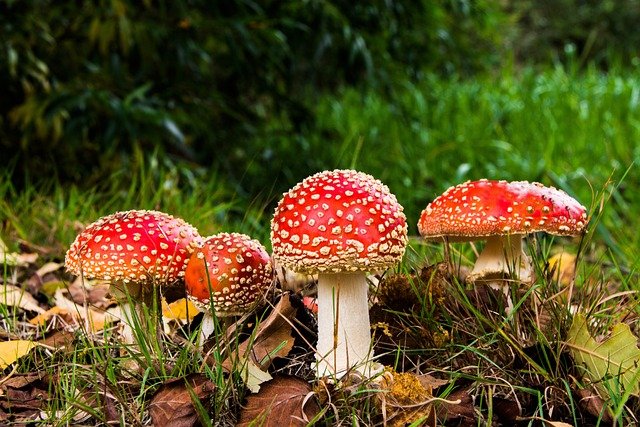In this article, you will learn about the dangerous consequences of consuming the deadliest mushroom varieties. We will discuss the potential risks and disadvantages of eating mushrooms, including the general risks, safety tips, and information about the deadliest varieties. We will also delve into the facts about white mold on mushrooms.
When it comes to consuming mushrooms, it is important to be aware of the potential risks and disadvantages. While mushrooms can be a delicious addition to your meals, some varieties can be extremely dangerous if ingested. From liver failure to hallucinations, the consequences of consuming the deadliest mushroom varieties can be life-threatening. It is crucial to know which mushrooms are safe to eat and which ones to avoid at all costs. Additionally, we will provide you with safety tips on how to properly identify and prepare mushrooms.

The Dangerous Consequences of Consuming Deadliest Mushroom Varieties
General Risks of Eating Mushrooms
Mushrooms are widely enjoyed and considered a delicacy in many cuisines around the world. Their unique flavors and textures make them versatile and appealing ingredients in various dishes. However, it is crucial to be aware of the potential risks and dangers that come with consuming certain mushroom varieties.
While most edible mushrooms are safe for consumption, there are some deadly species that can have severe consequences if ingested. It is essential to have a good understanding of these poisonous mushrooms to ensure your safety and well-being.
Toxic Effects of Deadly Mushroom Varieties
Among the deadliest mushroom varieties, three species stand out for their highly toxic effects – Amanita phalloides (Death Cap), Inocybe spp. (Fiber Cap), and Galerina spp. (Autumn Skullcap). These mushrooms can contain potent toxins that can cause severe damage to the liver, kidneys, and other vital organs.
Amanita phalloides, commonly known as the Death Cap, is responsible for the majority of mushroom-related fatalities worldwide. It contains toxins known as amatoxins, which can lead to rapid and irreversible liver failure if ingested.
Inocybe spp., particularly the Fiber Cap variety, contains toxic compounds called muscarine and muscimol. Ingesting these mushrooms can result in symptoms such as profuse sweating, vomiting, and digestive distress.
Galerina spp., specifically the Autumn Skullcap, produce a toxin called amanitin, which is similar to the one found in the Death Cap mushroom. Consumption of these mushrooms can lead to organ failure and even death.
Symptoms and Consequences of Mushroom Poisoning
When someone consumes these deadly mushrooms, the symptoms may not appear immediately. It can take several hours to a couple of days for the effects to manifest. Initially, individuals may experience nausea, vomiting, diarrhea, and abdominal pain. As the toxins begin to affect the liver and other organs, more severe symptoms emerge, such as jaundice, extreme fatigue, and confusion.
If left untreated, mushroom poisoning can lead to irreversible organ damage and, in some cases, death. Prompt medical intervention is essential in mitigating the harmful effects and improving the chances of survival.
Emergency Measures in Mushroom Poisoning Cases
If you or someone you know consumes a mushroom suspected to be toxic, it is critical to seek immediate medical assistance. Call emergency services or get the affected individual to the nearest hospital as soon as possible. While waiting for medical help, do not induce vomiting or administer any over-the-counter treatments without professional guidance.
Safety Tips for Mushroom Consumption
To minimize the risks associated with mushroom consumption, it is crucial to follow some safety guidelines. Firstly, always purchase mushrooms from reputable sources, such as grocery stores or farmers’ markets. Avoid picking wild mushrooms unless you are an expert in mushroom identification.
When preparing mushrooms, ensure thorough cooking. Heat can destroy some toxins present in certain mushroom varieties, reducing the risk of poisoning. Avoid eating mushrooms raw or undercooked, as this increases the chances of ingesting harmful compounds.
Identifying and Avoiding Deadliest Mushroom Varieties
As mentioned earlier, certain mushroom species can be deadly if consumed. However, it is possible to identify and avoid these deadly varieties to prevent any incidents. Understanding the specific characteristics of these mushrooms can aid in their recognition and subsequent avoidance.
Understanding Amanita phalloides (Death Cap) Mushroom
The Death Cap mushroom is typically pale green or yellow and resembles other innocuous edible mushrooms. It has a distinctive skirt-like partial veil and a bulbous base known as a volva. These features, coupled with its habitat near oak, chestnut, and beech trees, can help differentiate it from similar-looking mushrooms.
Facts about Inocybe spp. (Fiber Cap) Mushroom
Inocybe mushrooms, including the Fiber Cap variety, have a conical or bell-shaped cap with a fibrous texture. They often grow in woodland areas and can range in color from light brown to reddish-brown. It is important to note that Inocybe spp. can be difficult to distinguish from edible mushrooms, so caution is necessary when foraging.
Important Information about Galerina spp. (Autumn Skullcap) Mushroom
Galerina mushrooms, like the Autumn Skullcap variety, have a rusty brown or orange-brown cap and a slender stem. They typically grow on decaying wood and can be mistaken for harmless fungi. However, the presence of a rusty-brown spore print and a distinct annulus (ring) on the stem can help identify Galerina spp.
Conclusion
While mushrooms can be a delightful addition to culinary creations, it is essential to exercise caution when consuming them. The deadliest mushroom varieties, such as Amanita phalloides, Inocybe spp., and Galerina spp., can have severe toxic effects on the body.
By familiarizing yourself with the risks, symptoms, and methods of identification, you can protect yourself and others from the dangerous consequences of consuming these deadly mushrooms. Remember to always prioritize safety and consult experts when in doubt, ensuring a positive and enjoyable mushroom-eating experience.


